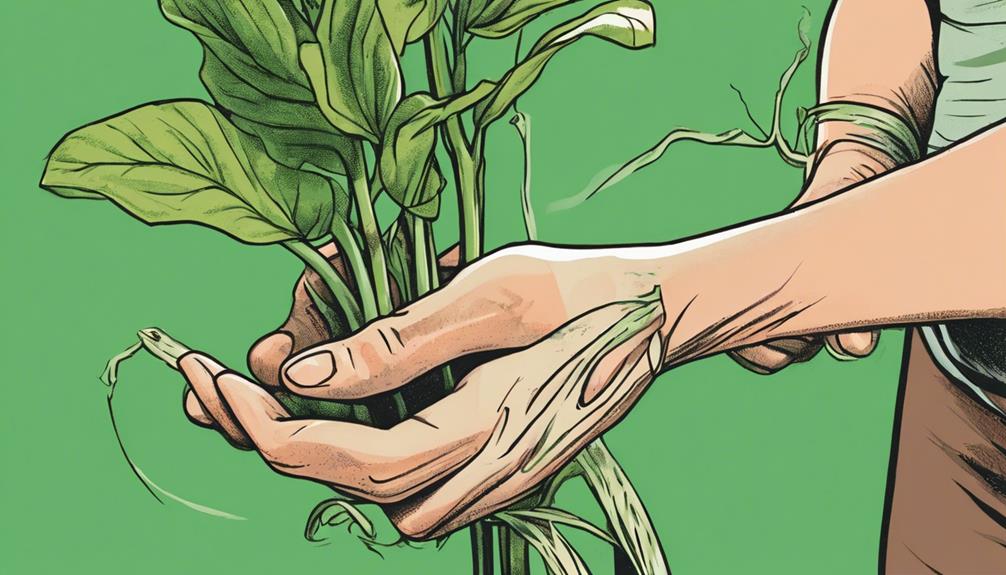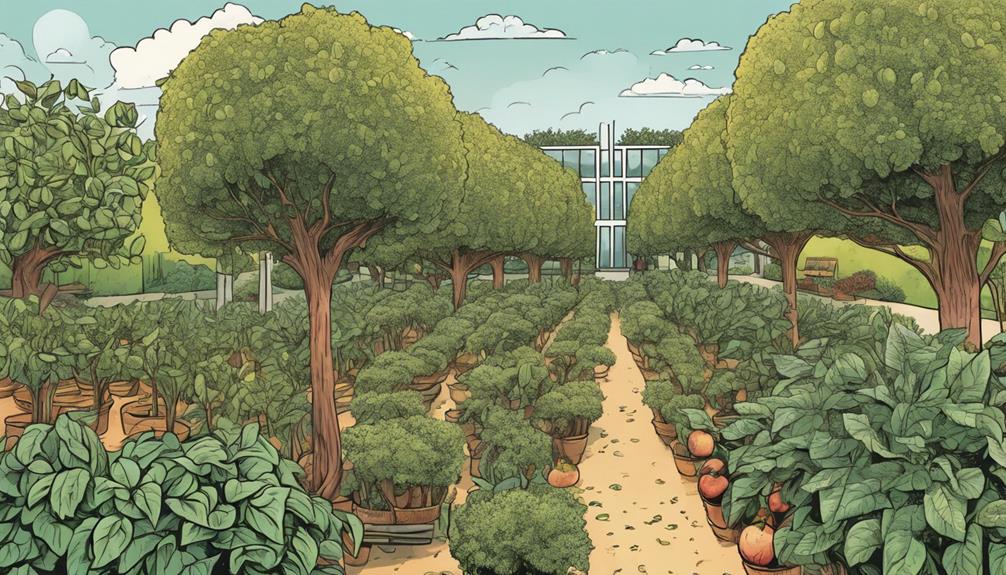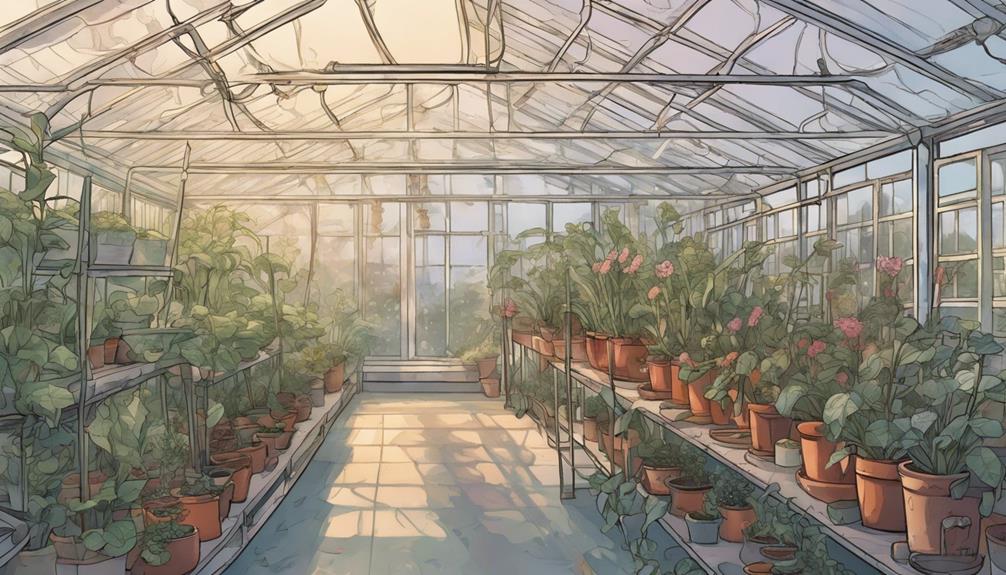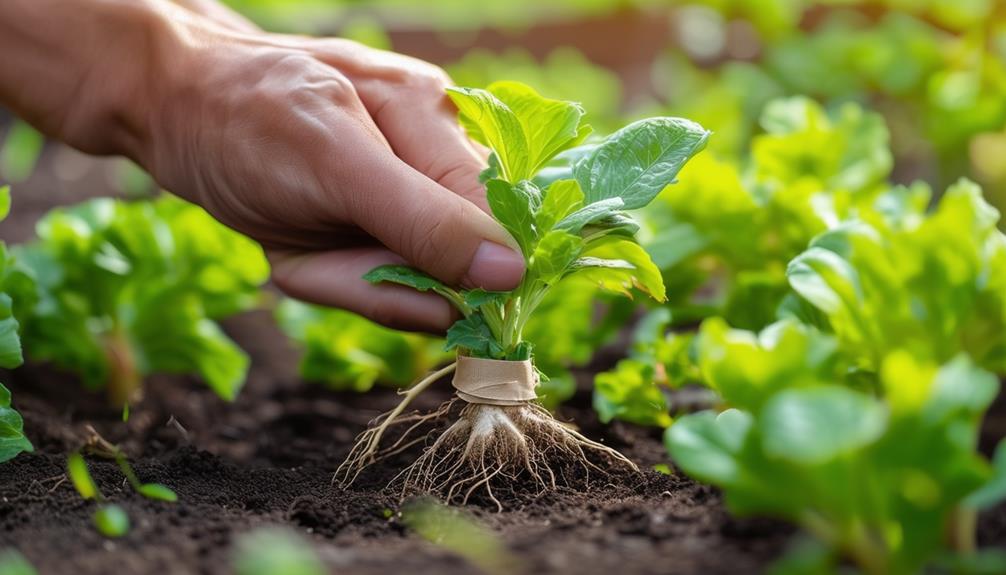You’re about to master the art of budding, a powerful propagation technique that produces genetically identical plants with improved crop yields and reduced disease susceptibility. By combining desirable traits with a robust root system, you’ll create strong and healthy plants. From T-budding to chip budding, you’ll discover various techniques to enhance crop yields and reduce production costs. Learn how to select compatible bud and rootstock, prepare them for grafting, and provide ideal environmental conditions for successful budding. As you progress, you’ll reveal the secrets to creating new plant varieties and improving crop quality – and that’s just the beginning of your budding journey.
Key Takeaways
• Budding is a propagation method that combines desirable traits of one plant with another’s root system for genetically identical plants.
• Mastering budding techniques like T-budding, chip budding, and patch budding enhances crop yields and reduces disease susceptibility.
• Proper selection of compatible bud and rootstock is crucial for healthy plant growth, considering factors like soil preferences, climate tolerance, and disease resistance.
• The budding process requires precise cuts, secure binding, and sealing to protect the budded area, followed by optimal environmental conditions for growth.
• Regular monitoring of bud union formation, pruning, and training are essential for successful budding, ensuring strong bond formation and healthy plant development.
Table of Contents
Budding: Efficient and Economical Propagation

Now that you’ve learned the basics of budding, it’s time to explore the principles and benefits of this technique. You’ll discover the advantages of budding, including increased efficiency and cost-effectiveness, as well as its various applications in horticulture. By understanding the benefits and principles of budding, you’ll be able to make informed decisions about when and how to use this valuable propagation method.
Understanding the Principles and Benefits of Budding
By embracing budding as a propagation method, you can effectively produce large numbers of genetically identical plants while minimizing costs and labor. This technique allows you to merge the desirable traits of one plant with the robust root system of another, creating a strong and healthy plant. Plant budding involves grafting a bud from one plant onto the rootstock of another, a process that requires precision and care. By mastering budding techniques, such as T-budding and chip budding, you can enhance crop yields, reduce disease susceptibility, and improve overall plant performance. As a grower, understanding the principles and benefits of budding can provide you with the opportunity to experiment with new plant varieties, enhance your propagation skills, and increase your crop’s overall quality. By grasping the fundamentals of plant grafting and budding, you’ll be able to elevate your plant propagation skills to the next level, unlocking new possibilities for your garden or nursery.
Advantages and Applications of the Budding Method
You can greatly reduce production costs and increase crop yields by adopting the budding method, which offers an efficient and economical way to propagate plants. This method is particularly valuable in horticulture, where large quantities of plants are needed for commercial production. By using techniques like T-budding and chip budding, you can produce high-quality plants with desirable traits, such as disease resistance or improved flavor. The budding method also allows you to propagate plants that are difficult to produce through seed or cuttings. Additionally, budding enables you to combine the desirable traits of a stem (scion) with the hardiness of a rootstock, resulting in a strong and healthy plant. Overall, the budding method offers a cost-effective and efficient way to produce large quantities of high-quality plants, making it an essential technique in modern horticulture. By mastering this technique, you can increase your crop yields, reduce production costs, and gain a competitive edge in the market.
Types of Budding Techniques
As you explore the world of budding, you’ll discover that different techniques can be used to achieve successful grafting. You’ll find that each method has its own strengths and weaknesses, making some more suitable for certain plants or situations than others. By understanding the various types of budding techniques, you’ll be better equipped to choose the right approach for your specific needs.
- T-Budding: Precision and Versatility
- Chip Budding: Speed and Efficiency
- Patch Budding: Propagating Thick-Barked Plants
- Inverted T-Budding: A Variation for Challenging Plants
T-Budding: Precision and Versatility
T-budding, a highly versatile and precise technique, allows grafters to join a single bud from a stem cutting to a rootstock, resulting in a strong and healthy union. When you master T-budding, you’ll be able to create high-quality grafts that thrive in your garden. This technique requires attention to detail and a bit of practice, but the payoff is well worth it. To get started, you’ll need a healthy stem cutting with at least one bud, a rootstock, and some grafting tape. Begin by making a T-shaped incision on the rootstock, then carefully remove a bud from the stem cutting and place it in the incision. Secure the bud with grafting tape, making sure it’s snug but not too tight. With proper care and maintenance, your grafted plant will flourish, providing you with a bountiful harvest. Remember to water and tend to your plant regularly, pruning as needed to promote healthy growth. By following these steps and dedicating time to gardening, you’ll be enjoying the fruits of your labor in no time.
Chip Budding: Speed and Efficiency
By swiftly removing a small chip of bark from the rootstock and inserting a bud from the stem cutting, chip budding streamlines the grafting process, saving time and effort without compromising the quality of the union. This technique is ideal for large-scale budding operations or when working with numerous plants. You’ll find it’s especially useful when dealing with delicate or sensitive buds that require careful handling.
To begin, prepare your rootstock and stem cutting as you would for T-budding. Next, make a small, shallow cut on the rootstock, about 1-2 inches from the base of the plant. Gently pry open the bark, creating a small pocket. Now, take the bud from the stem cutting and carefully insert it into the pocket, ensuring the cambium layers align. Secure the bud with a small piece of tape or grafting rubber. Repeat this process for each bud, working efficiently to minimize handling and maximize your budding success.
Patch Budding: Propagating Thick-Barked Plants
You’ll find patch budding particularly useful when working with thick-barked plants, as it allows you to accommodate larger buds and successfully propagate these more challenging specimens. This technique is ideal for plants with rough, thick bark, as it provides a larger surface area for the bud to attach to the rootstock. To begin, prepare your rootstock by cutting a rectangular patch of bark, about 1-2 inches square. Then, carefully remove a bud from the donor plant, making sure to include a small piece of stem and some leaf tissue. Next, place the bud on the prepared rootstock, aligning the cambium layers (the thin layer of tissue just beneath the bark). Secure the bud in place with grafting tape or a specialized budding rubber. Finally, wrap the entire area with a rubber band or tape to hold the bud firmly in place. With proper care, the bud should begin to grow, eventually forming a strong bond with the rootstock.
Suitable Plants and Rootstocks for Budding

When preparing to bud your plants, it is crucial to choose the right plants and rootstocks for successful grafting. You’ll want to select plants that are compatible with each other and suitable for budding. By doing so, you’ll increase the chances of a successful graft and a healthy, thriving plant.
- Fruit Trees: Citrus, stone fruits, and other fruit trees are popular choices for budding.
- Ornamental Trees and Shrubs: Roses, maples, and other ornamental plants can also be budded.
- Matching Bud and Rootstock Compatibility: Make sure the bud and rootstock are compatible to promote healthy growth.
- Specialized Rootstocks: Some rootstocks are bred specifically for budding, offering improved disease resistance and hardiness.
Fruit Trees: Citrus, Stone Fruits, and More
Selecting the right fruit tree varieties and compatible rootstocks is essential for successful budding, especially when working with popular choices like citrus, stone fruits, and other deciduous tree species. You’ll want to choose varieties that are compatible with your local climate and soil conditions. For citrus, dwarfing rootstocks like ‘Flying Dragon’ or ‘Dwarf Washington’ are great options. For stone fruits like peaches and plums, ‘Lovell’ or ‘Myrobalan’ rootstocks work well. When selecting fruit tree varieties, consider factors like disease resistance, ripening time, and flavor profile. Some popular citrus varieties for budding include ‘Valencia’ oranges, ‘Meyer’ lemons, and ‘Satsuma’ mandarins. For stone fruits, ‘Bartlett’ pears, ‘Red Haven’ peaches, and ‘Santa Rosa’ plums are popular choices. Make sure to research the specific budding requirements for each variety, as some may have unique needs. By choosing the right fruit tree varieties and compatible rootstocks, you’ll be well on your way to successful budding and a thriving orchard.
Ornamental Trees and Shrubs: Roses, Maples, and Others
Many ornamental trees and shrubs, including roses, maples, and crabapples, can be budded using specific rootstocks that enhance their growth and survivability. You can create stunning landscape features by budding ornamental trees and shrubs onto rootstocks that provide improved disease resistance, pest tolerance, or enhanced growth rates. For instance, you can bud a rose variety onto a rootstock that’s resistant to nematodes, guaranteeing your beautiful blooms will thrive.
When selecting rootstocks for ornamental trees and shrubs, consider factors like soil preference, climate tolerance, and growth habits. Some popular rootstocks for ornamental trees and shrubs include Rosa multiflora for roses, Acer spp. for maples, and Malus spp. for crabapples. Make sure you’re using disease-free and pest-free rootstocks to prevent the spread of diseases. By choosing the right rootstock, you’ll be able to enjoy vibrant, healthy, and thriving ornamental trees and shrubs in your garden or landscape.
Matching Bud and Rootstock Compatibility
You’ll need to carefully match the bud and rootstock compatibility to guarantee a successful budding process, considering factors like growth habits, soil preferences, and climate tolerance. This compatibility is vital, as it ensures that the bud grows well with the rootstock, resulting in a healthy and thriving plant.
When selecting a bud and rootstock, consider the plant’s growth habits, such as deciduous or evergreen, and its mature size. Soil preferences, like acidic or alkaline, must also be compatible. Climate tolerance is another essential factor, as some plants are more sensitive to extreme temperatures or moisture levels.
For example, if you’re budding a rose, you’ll want a rootstock that’s resistant to black spot, a common disease affecting roses. You’ll also want to choose a rootstock that’s compatible with the rose’s growth habits, such as a vigorous or compact growth pattern. By carefully matching the bud and rootstock, you’ll increase the chances of a successful budding process and a healthy, thriving plant.
Step-by-Step Budding Process
Now that you’ve selected suitable plants and rootstocks for budding, it’s time to get hands-on with the step-by-step budding process. You’ll need to carefully prepare the bud and rootstock, make precise cuts, and securely insert the bud to guarantee a successful graft. By following these detailed steps, you’ll increase your chances of success and grow healthy, thriving plants.
| Step | Action | Tips |
|---|---|---|
| 1 | Select and prepare the bud and rootstock | Confirm the bud is plump and the rootstock is vigorous |
| 2 | Make the budding cuts | Use a sharp, sterile knife and make clean, angled cuts |
| 3 | Insert the bud | Gently push the bud into place, ensuring a snug fit |
| 4 | Secure the bud | Use a suitable binding material to hold the bud in place |
| 5 | Seal and protect the budded area | Apply a grafting wax or sealant to prevent water loss and infection |
Selecting and Preparing the Bud and Rootstock
Select the healthiest, disease-free bud from the parent plant, ideally with a slight swelling at the base, and a section of rootstock with a similar diameter to the bud’s stem. This guarantees a strong, healthy union between the two. When choosing your bud, look for one that’s plump and firm, with no signs of disease or pests. If you’re using a dormant bud, make sure it’s stored in a cool, dry place to prevent moisture buildup.
For the rootstock, choose a section with a similar diameter to the bud’s stem. This will make it easier to create a strong bond between the two. Cut the rootstock from the parent plant, making sure to leave a small section of stem attached to the roots. Remove any lower leaves or weak growth from the rootstock, leaving only the strong, healthy stems. Now you’re ready to prepare your bud and rootstock for grafting. Make sure to handle them gently to avoid damaging the delicate tissues. With your bud and rootstock prepared, you’re one step closer to successfully budding your plants.
Making the Budding Cuts: Precision and Timing
With your bud and rootstock prepared, it’s time to make the precise cuts that will bring them together in a strong, healthy union. You’ll need to make two diagonal cuts, one on the rootstock and one on the bud, to create a clean surface for the union. Hold the bud at a 45-degree angle and make a diagonal cut about 1 inch long, starting from the top and sloping downward. This will help you remove excess stem tissue and expose the cambium layer. Next, make a similar cut on the rootstock, ensuring the cuts are identical in length and angle. This precision is vital, as it allows the bud to fit snugly onto the rootstock. Take your time, and don’t rush through this process – the quality of the cuts will directly impact the success of the budding process. Remember, it’s better to take small, gentle cuts, checking your work as you go, rather than making a mistake that could compromise the entire union.
Inserting and Securing the Bud
You’ll carefully slide the bud onto the rootstock, aligning the cambium layers and making certain a snug fit. Make sure the bud is positioned at the same angle as the rootstock’s branch, with the bud’s base aligned with the cut on the rootstock. You’ll know it’s in place when the bud feels securely seated.
Next, wrap the bud gently but firmly with budding tape, starting from the base of the bud and moving upwards. Apply gentle pressure to make certain the tape adheres evenly. Make sure the tape isn’t too tight, as this can constrict the bud. You want the tape to hold the bud in place without restricting its growth.
As you wrap, ensure the tape covers the entire cut area, protecting it from drying out. Use enough tape to secure the bud, but avoid over-taping, which can cause moisture buildup. Once you’ve finished wrapping, gently tug on the bud to ascertain it’s securely attached. If it feels loose, rewrap the area to achieve a snug fit.
Sealing and Protecting the Budded Area
Now that the bud is securely attached, seal the area with a thin layer of grafting wax or sealant to protect it from drying out and promote callus formation. This step is essential in ensuring the bud takes hold and grows successfully. Apply the wax or sealant evenly, making sure to cover the entire area where the bud meets the rootstock. Be gentle but firm when applying the wax, as you want to create a tight seal without pressing too hard and damaging the bud.
Next, inspect the area for any gaps or openings that might allow air to reach the bud. If you find any, apply a small amount of wax or sealant to fill them in. This will create a protective barrier that prevents moisture loss and promotes healthy growth. Finally, check the sealed area for any signs of excess wax or sealant, gently removing any excess material to prevent it from interfering with the budding process. By following these steps, you’ll create a secure environment for your bud to thrive and grow into a healthy, thriving plant.
Aftercare and Bud Development

Now that you’ve successfully budded your plant, it’s essential to provide ideal conditions for the bud to develop. You’ll need to monitor the bud union‘s formation and growth, as well as encourage bud break and shoot development. By following these steps, you’ll be well on your way to growing a healthy, thriving plant.
Providing Optimal Environmental Conditions
Daily watering and high humidity help create ideal environmental conditions for the newly budded plant, allowing the bud to develop and grow successfully. You’ll want to maintain a consistent moisture level, but avoid overwatering, which can lead to root rot. High humidity, typically above 60%, will help the bud heal quickly and reduce transpiration. You can achieve this by covering the plant with a clear plastic bag or a cloche.
Keep your budded plant in a bright, indirectly lit area, but avoid direct sunlight, which can cause stress. Sustain a temperature between 65°F to 75°F (18°C to 24°C), which is ideal for most plants. Ensure good air circulation to prevent fungal diseases. You can accomplish this by providing at least 6-8 inches of space between plants.
Monitoring Bud Union Formation and Growth
During the first few weeks after budding, inspect the bud union regularly to make sure a strong, healthy bond is forming between the bud and rootstock. You’ll want to check for any signs of infection, disease, or pest damage. Gently remove any wrapping or tape from the bud union to inspect the area. Look for a callus, a small, whitish-colored tissue that forms over the bud, indicating a successful graft.
As the bud develops, you’ll notice the formation of a small swelling at the base of the bud, which will eventually grow into a shoot. Make sure the area around the bud union is kept moist but not waterlogged, as this can lead to root rot. You may need to adjust your watering schedule to accommodate the budding process. Monitor the bud’s progress, taking note of any changes or abnormalities. By keeping a close eye on the bud union, you’ll be able to identify any potential issues early on and take corrective action to guarantee a successful graft.
Forcing Bud Break and Shoot Development
After the bud union has formed, you’ll want to provide ideal conditions to stimulate bud break and promote healthy shoot development. This is a critical stage where you’ll need to create an environment that fosters growth. Make sure your plant receives adequate light, ideally indirect sunlight, to promote photosynthesis. Maintain a consistent temperature between 65°F to 75°F (18°C to 24°C) to promote cellular activity. Water your plant regularly, but avoid overwatering, which can lead to root rot. Fertilize your plant with a balanced, water-soluble fertilizer to provide essential nutrients. Prune any dead or damaged leaves to prevent the spread of disease and encourage healthy growth. Monitor your plant’s progress, and remove any weak or spindly shoots to direct the plant’s energy towards stronger growth. By providing ideal conditions, you’ll encourage your plant to break bud and develop strong, healthy shoots. With proper care, your plant will thrive, and you’ll be on your way to a successful budding process.
Pruning and Training the Budded Plant
As your plant begins to produce new growth, you’ll need to prune and train the budded plant to maintain its shape, promote healthy development, and encourage a strong framework. Pruning involves removing any weak or damaged growth, which helps direct the plant’s energy towards healthy shoots. Start by removing any dead or diseased branches, and then cut back the tip of the leader shoot to encourage branching. This will help create a strong, well-balanced framework for your plant.
Training involves gently shaping the plant to maintain its desired shape and promote even growth. You can use stakes, trellises, or other supports to guide the plant’s growth. As the plant grows, continue to prune and train it regularly to maintain its shape and promote healthy development. Remember to remove any suckers or water sprouts that may appear, as these can divert energy from the rest of the plant. By following these steps, you’ll be able to create a strong, healthy plant that will thrive for years to come.
Frequently Asked Questions
Can I Bud Plants in the Winter When They’re Dormant?
You’re wondering if you can bud plants in the winter when they’re dormant. The answer is yes, but with care. Winter budding can be successful, especially with deciduous plants, as they’re less stressed during dormancy. However, make sure the rootstock is healthy and the budwood is collected from a dormant, disease-free plant. Timing is important – bud during late winter or early spring, when the plant is still dormant, for the best results.
How Do I Store Budding Tools and Equipment Properly?
When you’re not using your budding tools and equipment, store them properly to maintain their quality and extend their lifespan. Clean and dry your tools, then store them in a dry, cool place. Keep your budding knife sharp by storing it in a protective case or wrapping it in a soft cloth. Label and organize your equipment, like budding tape and rubber strips, in a designated container to guarantee easy access and prevent damage.
What Are the Signs of Disease in Newly Budded Plants?
You’re like a detective searching for clues when inspecting your newly budded plants for signs of disease. Look for yellowing or droopy leaves, black or white spots, or a sticky substance on the stems or leaves. Check for soft, mushy spots or a foul odor. If you notice any of these signs, isolate the infected plant immediately to safeguard the health of your budding beauties. Inspect your plants regularly to catch any issues early, and take action promptly to secure the health of your budding beauties.
Can I Use Budding to Combine Two Different Plant Species?
You’re wondering if you can combine two different plant species through budding. The answer is yes, but with caution. When budding two species, make sure they’re compatible and from the same plant family or genus. This increases the chances of a successful graft. Research the specific budding requirements for each species, as some may have unique needs. By following proper techniques and choosing compatible species, you can successfully combine two plant species through budding.
How Long Does It Take for a Budded Plant to Produce Fruit?
As you patiently nurture your budded plant, you’re excited to savor the fruits of your labor – literally! The wait can be tantalizing, but it’s worth it. Generally, it takes around 1-3 years for a budded plant to produce fruit, depending on factors like the plant species, climate, and care. With proper nurturing, your plant will flourish, and you’ll be enjoying juicy rewards in no time!
Conclusion
You’ve successfully navigated the world of budding, harnessing the power to create superior plants that will revolutionize your garden. As you “dial up” your propagation skills, remember that practice makes perfect, so don’t be discouraged if it takes a few tries to get the hang of it. With patience and persistence, you’ll be “leveling up” your plant game in no time, cultivating robust, disease-resistant, and high-yielding plants that will be the envy of all your gardening friends.
Back to our main Grafting Guide.

